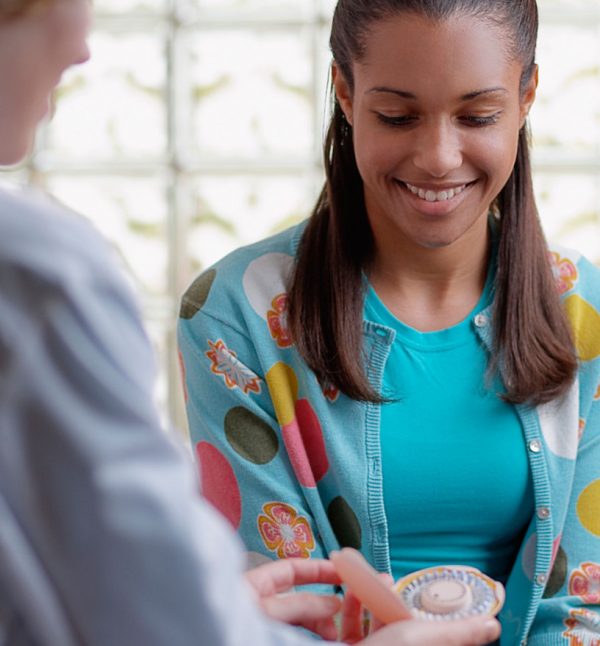Birth Control
Birth control, also called contraception, is what people do to prevent pregnancy. Using a reliable method of birth control can be challenging for youth because they may not have the knowledge, money and transportation to access health care1
Street involved youth may face additional challenges using reliable contraception because:
- addressing basic needs often takes priority over preventing pregnancy
- even greater challenges with access
- some might want to become pregnant because they see it as a way to get off of the streets2
How Pregnancy Happens
Risk Factors for Unintended Pregnancy
Pregnancy is when an egg that’s been fertilized by a sperm implants into the uterus’ lining.
- This usually happens through vaginal sex
- It can happen anytime a penis or semen come in direct contact with the vaginal area
- It can also happen from a medical procedure at a fertility clinic
- Age of less than 30 years old
- Frequent intercourse
- Lifestyle (e.g., street involvement) that make correct and consistent use of birth control difficult
- Known use of alcohol and/or other substances
- Previous contraceptive failure
For more information on pregnancy, click here.
Choosing and Getting Birth Control
Having accurate, comprehensive information about a variety of birth control methods can help youth make birth control choices that are right for them. Youth may need support accessing birth control or advocating for free supplies.
How Birth Control Works
People have different values about birth control. Understanding how any given birth control works can help youth choose a birth control that is effective and fits within their value system. Birth control works one of these ways:
- stopping the ovaries from releasing an egg
- stopping the sperm from fertilizing an egg
- stopping a fertilized egg from implanting in the uterus
Methods that use more than one of these actions are often more effective.
How to Get Birth Control
Youth do not need to be a certain age or to get parental consent to get birth control. Different types of birth control methods are accessed in different ways. They can be:
- bought off the shelf like condoms and some types of emergency contraception
- available by prescription that you get from a doctor, fill at a pharmacy and then take yourself like the birth control pill, patch or ring
- available by prescription and then given to you by a health care provider like the IUD, implant or birth control injection
Birth control can be available for free.
Alberta youth can get free birth control and safer sex supplies:
Youth living outside of Alberta may find free birth control and other sexual health services here: https://www.actioncanadashr.org/resources/services
If they ask, people may also be able to get free, or “compassionate” birth control from their doctor or walk-in clinic.
Talking to Youth about Choosing Birth Control
When supporting youth think about choosing birth control, ask youth about:
- how often they want to think about and use it
- how complicated it is to use
- their values about how methods work
- when and if they want periods
- what has and hasn’t worked for them before
- their health conditions and medical history
- what they’re interested in using
- when and if they ever want to get pregnant
- their STBBI risk

Key messages to share with youth about choosing birth control:
- abstinence is the only 100% effective birth control method
- the most effective method of birth control is one that can be used correctly and consistently
- long acting birth control is usually more effective than shorter acting methods that require youth to frequently think about and use them
- dual protection (using a condom plus another type of birth control) gives better protection from pregnancy AND gives protection from STBBI
- emergency contraception is a birth control option after unprotected sex
Types of Birth Control
Basic information about some of the more common methods of birth control can be found below. Some are methods that are readily available to and effective for youth. Other types listed may be are ones they’ve heard of or are interested in.
For detailed information on birth control methods, see:
- My Health Alberta, and search “birth control.”
- Contraceptive Methods Booklet.
Natural Methods
Natural methods of birth control use behavior, not medication or devices, to prevent pregnancy.
Effectiveness of these methods requires willingness to consistently engage in the behavior and specific understanding of one’s body, fertility and the method.
Abstinence means not doing something. To prevent pregnancy, abstinence is not doing anything where a penis or semen come in direct contact with the vaginal area (e.g. vaginal or anal sex). To lower STI risk, people abstain from a broader range of activities. For more on abstinence as STI prevention, click here.
Withdrawal is when the penis is pulled out of the vagina before ejaculation. There are live sperm in pre-ejaculatory fluid at the tip of the penis throughout an erection, so, withdrawal is about 78% effective.4
Fertility Awareness Based (FAB) methods are about having sex when a person is least likely to be fertile. The most effective FAB methods are taught by experts and rely on a variety of fertility indicators like temperature, cervical mucous and menstrual cycle charts.
Lactation Amenorrhea (LAM) is when someone doesn’t get a period while breastfeeding. Sometimes, this means they’re not releasing eggs. People need instruction from a health care provider to use LAM effectively.
For more information about natural methods: https://www.sexandu.ca/contraception/natural-methods/
Short Acting Hormonal Contraception
Hormonal methods of birth control contain hormones, or body chemicals, that are similar to a person’s natural ones.
They are very effective when used correctly and consistently, but effectiveness diminishes significantly with inconsistent or incorrect use.
Combined hormonal contraception (CHC) contains 2 hormones, estrogen and progesterone. They stop a person from releasing an egg. Some types of CHCs can be safely used to stop periods, manage period symptoms and treat acne.
- Birth control pills (Combined oral contraception or COC) are swallowed every day as directed by the health care provider. Taking the pill at the same time every day is important.
- Birth control patch is worn on the skin and changed once a week. If the patch comes off, it’s important to talk with a pharmacist or health care provider to find out if a replacement is needed.
- Birth control ring is inserted by the person into their own vagina. It is replaced by the person after 3 weeks. When inserted properly, the person can’t feel the ring in their vagina.
Progestin Only Pills (POPs), also called the mini-pill contain only one hormone. This means that this type of birth control often can be used by people who can’t take estrogen. They stop the sperm from reaching the egg, change the uterine lining to make implantation difficult and sometimes top the ovaries from releasing an egg. Taking the pill at the same time is very important.
Birth control injection, also called the shot or by it’s brand name, Depo-Provera, contains only one hormone that is injected by the health care provider. It stops the sperm from reaching the egg, change the uterine lining to make implantation difficult and sometimes top the ovaries from releasing an egg. This birth control lasts 12 weeks before another injection is needed.
For more information about hormonal IUDs: https://www.sexandu.ca/contraception/hormonal-contraception/#tc4
Long Acting Reversible Contraceptives (LARCs)
LARCs are very effective because of how they work and how easy they are to use. When given information and access, LARCs tend to be the preferred birth control choice for most youth.
Long acting means that these types of birth control can last at least a year.
Reversible means that a person can stop the birth control and their fertility returns.
Intrauterine devices (IUDs), are medical devices that are inserted into the uterus by a health care provider. Before inserting an IUD, the health care provider will make sure the person isn’t pregnant and doesn’t have a vaginal infection.
- Hormonal IUDs slow sperm so they don’t meet the egg, changes the uterine lining so a fertilized egg doesn’t implant and may stop ovaries from releasing an egg. They can stay in up to 5 years.
- Copper IUDs kill sperm and changes the lining of the uterus so a fertilized egg doesn’t implant. Depending on the type, copper IUDs can stay in up to 10 years.
Birth control implant is a medical device that is inserted under the skin on the bottom side of a person’s upper arm. It works by slowing down sperm so they don’t meet the egg, changing the lining of the uterus so a fertilized egg doesn’t implant and may stop a person from releasing an egg. It can stay in up to 3 years.
For more information about hormonal IUDs: https://www.sexandu.ca/contraception/hormonal-contraception/#tc4
Barrier Methods
Barrier methods involve a device that blocks the sperm from reaching an egg. Some require spermicides for effective use. Even with perfect use, barrier methods are not as effective as many other methods.
Condoms – the only birth control method that also provides good STI protection to those who are have sex. For detailed information on condoms, click here
Sponge – a firm foam-like device containing a spermicide. It’s put into the vagina before sex and left in for several hours afterwards.
Diaphragm -silicone or plastic devices put into the back of the vagina before sex. They are usually used with a special spermicidal cream.
For more information about barrier methods, see: https://www.sexandu.ca/contraception/non-hormonal-contraception/
Spermicides
Spermicides are chemicals that are intended to kill sperm. They might be found in Canada as a foam or film that’s put in the vagina before sex. On their own, spermicides are not particularly effective. Nonoxynol-9 is the active ingredient in many spermicides. Spermicides can cause irritation. Irritation increases the risk of infections, including STI.
Permanent Birth Control
Surgical procedures provide birth control by surgically blocking the sperm and egg from meeting. This birth control is considered permanent and reversing it can be difficult, costly and is not always effective.
- Vasectomy blocks the vas deferens so sperm does not get ejaculated in the semen.
- Tubal ligation (getting tubes tied) blocks the fallopian tube so the egg and sperm do not meet.
Emergency Contraception (EC)
Emergency contraception is birth control that is taken after sex but before a pregnancy occurs. EC does NOT end pregnancy.
It is used in case of emergencies like:
- incorrect use of another method of birth control (e.g. missed birth control pills)
- condom breaking
- sex without a condom or other reliable method of birth control
- sexual assault
Levonorgestrel (e.g. Plan B, Contingency 1) is an emergency contraceptive pill that can be bought at any store with a pharmacy. It doesn’t need a prescription. It works best if taken in the first 24 hours after sex, but can be used up to 5 days.
Ulipristal acetate (e.g. Ella) is an emergency contraceptive pill that is available by prescription. It is equally effective up to 5 days after sex.
Copper IUD can be used as emergency contraception up to 7 days after sex. It is prescribed and inserted by a health care provider. It’s important to contact the clinic to find out if they offer this service.


